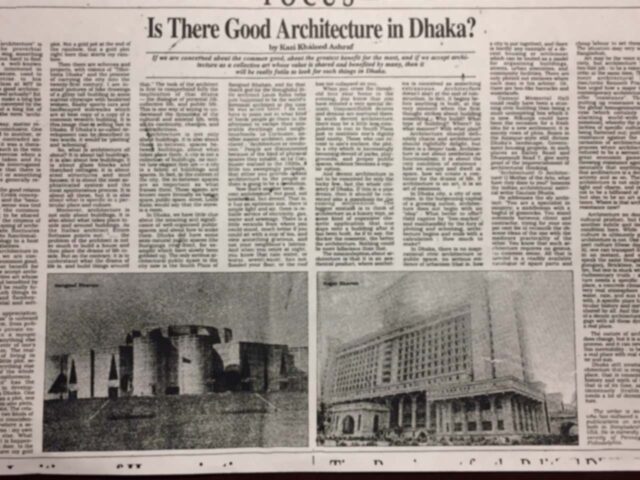

Needless to say, matter remained quite inconclusive. One item would lead to another, or one item would contradict another. Anyway, it was a therapeutic lesson, much in the vein of a Socratic exercise when a certain idea is taken and its given meaning is interrogated to finally realize that there is much more to it or something else to it than is generally realized.
One sense of the good relates it to the ancient Greek conception of the “good” and the “beautiful”. The Greek sense was tied to their idea of the common good, something to be shared and benefitted by the citizens of the polis. The meaning of the architecture meanwhile fluctuates from aesthetics to the functionalism, from technology to a host of other slippery themes.
Is there good architecture in Dhaka then? If we were concerned about the common good, about the greatest benefit for the most, and if we accept architecture as a collective art whose value is shared and benefitted by many, then it will be really futile to look for such things in Dhaka. Flashy and flamboyant, yes. Substantial and serious, hardly.
In Dhaka, the appreciation of shared “goodness” is unheard of. Almost everyone, from public institution or private enterprises, lives in a myopic world, not seeing anything else beyond the perimeter of one’s immediate kingdom. The reality and the symbol of living in Dhaka is this one little plot, sequestered from everything else even if the rest of the world is blown to smithereens.
The word “plot” has the hugest currency in development vocabulary in Dhaka. One sells a plot, one owns a plot, one builds on a plot. One also plots, that is, hatches a plot. The relation between these two kinds of plot certainly is not coincidental. There is everywhere a severe plot-mindedness: my own plot and nothing else. What does it matter what is happening in the next door. To the city as long as I have my gold plot, not a gold plot at the end of the rainbow, but a gold plot right here that starts my rainbow.
Then there are schemes and projects with visions of “Tilottoma Dhaka” and the promise of carrying the city into the twenty first century. I see instead pictures of fake drawings of a glitzy tall building in some surreal cityscape with beskirted woman, flashy sports cars and landscaped sidewalks that are at best copy of copy of western buildings. It is the image that is selling fast in Dhaka. If Dhaka’s so called development can be described in two words, it would be “plotting” and “scheming”.
So what is architecture all about? It is about tall buildings, it is also about low buildings; it s about glass blocks, and also about thatched cottages. It is about steel structures and mud houses; it is about the most sophisticated system and most spontaneous process, but it is also about what is specific in a particular place and culture.
Moreover, architecture is not only about buildings, it is also about what takes place inside and around buildings. As the Italian architect Ettore Sottsass points out “…. The problem of the architect is not so much to build a house and then place the drama of life inside. But on the contrary it is to understand what the drama of life is, and build things around that”. The task of the architect is first to comprehend fully the implication of that drama – the dialogue of personal life, collective life and public life. This is one way of saying to understand the dynamics of the cultural and the societal life, with all its continuity, changes and contradictions.
Architecture is not only about buildings; it is also about those in-between spaces between buildings, about what takes place there. A city is not a collection of buildings, no matter how elegant they are – a city is a fabric of buildings and spaces. In fact, in the context of the city, the in-between spaces are as important as what frames them. The spaces are known more formally as urban spaces, public spaces, streets. Louis Kahn would say that the street is a room.
In Dhaka we have little clue about the meaning and significance of public spaces and about how to make them. Dhaka did have some semi-natural public spaces (the Buriganga river-front as example) which has slowly been gobbled up. The only serious architectural public space in the city now is the South Plaza of Sangsad Bhaban, and for that thank god for the thoughtful little architect Louis Kahn (who just happened to be the world’s foremost architect at the time he was active here). I do not have to point out in what kind of horde people go there in the afternoon to escape their miserable dwellings and neighborhoods. Le Corbusier, another master architect once declared: “Architecture or Revolution”. People are discontented because of the kind of the physical space they inhabit, so Le Corbusier warned in the 1920s, a little too sweepingly perhaps, that either you provide decent architecture to the people or there is going to be a revolution.

Now that’s another term: decent architecture, not good, not aesthetical but decent. That is, it has an optimum size, there is ample light and air, there is reliable service of electricity, gas, water and sewerage. There is a little veranda from where you could stand, much better if you could sit with a cup of tea, and view something gracious, and not your neighbour’s latrine. And when you retire at night, you know that rain-water or worse, sewer water has not flooded your floor, or the roof has not collapsed on you.
When you cross the threshold into your home in the evening, you know that you have entered a very special domain. Unquantifiable desire and dreams are nurtured there. In such decent architecture, there maybe a little less compulsion to run to the South Plaza just to maintain one’s dignity and sanity. Those who can retreat to one’s enclave, the plot. In a city which is increasingly becoming devoid of parks, playgrounds and proper public spaces, violence become a regular option.
And decent architecture is not to be conceived for only the lucky few but the whole citizenry of Dhaka. If this is a pipe dream, then it should be converted into a manifesto for the coming millennium. The biggest mistake is to think of architecture as a luxury item, as some kind of expensive cosmetic application that one slaps onto a building after it has been built. As if to say, the thicker, the cosmetic, the better the architecture. Nothing could be more fallacious than that.
The misconception about architecture is that it is an aesthetical product, where aesthetics is conceived as something extraneous. Architecture doesn’t start at the end of construction. In fact, it begins before anything is built. At the very moment when the first thought strikes about building something, Why build? What type of building? Where? In what manner? With what plan?
Architecture should definitely charm and architecture should rightfully delight, but there is a deeper task. Architecture is not about aesthetics or functionalism: it is about the very condition of existence: how we occupy and dwell in peace, how we create a container of the drama of life. If architecture is an art, it is an art of existence.
In Dhaka city, a city of one crore, in the burgeoning capital of a growing nation, architecture does not begin with an “idea”: what better to offer? Held captive by “free market, and manhandled by the fury of plotting and scheming, architecture begins and ends with a calculation: How much to make?
In Dhaka, there is no inspirational civic architecture or public space, no serious evidence of urbanism (that is, how a city is put together), and there is hardly any example of a decent housing or settlement which can be touted as model for organizing building, streets and urban amenities and community facilities. There are only plotted out enclaves where each man is his arbiter. Or there are box-like barracks and wastelands.
Osmani Memorial Hall could really have been a stunning civic building than being a mute uninspiring box which it is now. Nikunjo could have been the occasion for a fresh idea for a new settlement; it is merely a rows of plots. Boxes in the Azimpur-style still dictate Dhaka’s landscape. Government housing projects, in such places as Baily Road and Dhanmondi Road 7 give sorry proof of an impoverishment of architectural thinking.
“Architecture! O Architecture! O Mother of Arts, what have they done to you?” laments the Indian architectural satirical writer Gautam Bhatia.
He addresses the sly architect: “You are the specialist in mimicry, a middleman with a bagful of gimmicks. You stand solemnly between client and contractor, trying for your one percent fee to reconcile the obscene ideas of the one with mediocre practically of the other. You know that such architecture requires no genius, no common sense. All that you need is a readily available catalogue of spare parts and cheap labour to set them up.” The situation may very well be Bangladesh.
Art maybe the voice of a society, but architecture has a two-fold job: to be a voice and a critic at the same time. The eminent architectural historian and critic Kenneth Frampton urged how a major task of contemporary architecture is to offer “resistance”. That is, putting up resistance against the global homogenization process (which certainly is an alarming worldwide phenomenon), whereby the particularities of specific cultures are being flattened out; putting out resistance against the monetisation of architecture, the process where architecture is reduced to be servant of the great economic game; and throwing resistance against the mentality that anything goes, that architecture is a decorative activity and so on. The job of architecture is not only to delight and charm, and certainly not to be a billboard of money but also to be an art of resistance. Where is that architect of resistance now?
Architecture is no doubt a cultural product, but there is another subtle and important condition here. While most of culture is ultimately portable, architecture is not. One can import culture (these days beam it). One can transport life-style in an instant. And one can speak the same Bengali on Begumganj, Bricklane or Brooklyn, but one is stuck with a very rudimentary truth: architecture needs a specific site and place, a concrete climate and a very real atmosphere of wind, water, rain and sun to reckon with. A specific place has a particular history and myth that is shared by all. And the criterion of a decent architecture is to engage all these dynamics of a real space.
The nature of architecture does change, but it is a very slow process, and it can never escape this inevitability: to be stuck in a real place with real wind, water and sun.
Dhaka still awaits that architecture that is responsive to place, that is consciousness of the history and the myth of the place that is of its time, and that is immensely livable. Dhaka needs a lot of decent architecture.
By Kazi Khaleed Ashraf
Published in The Daily Star, on 12th August, 1998